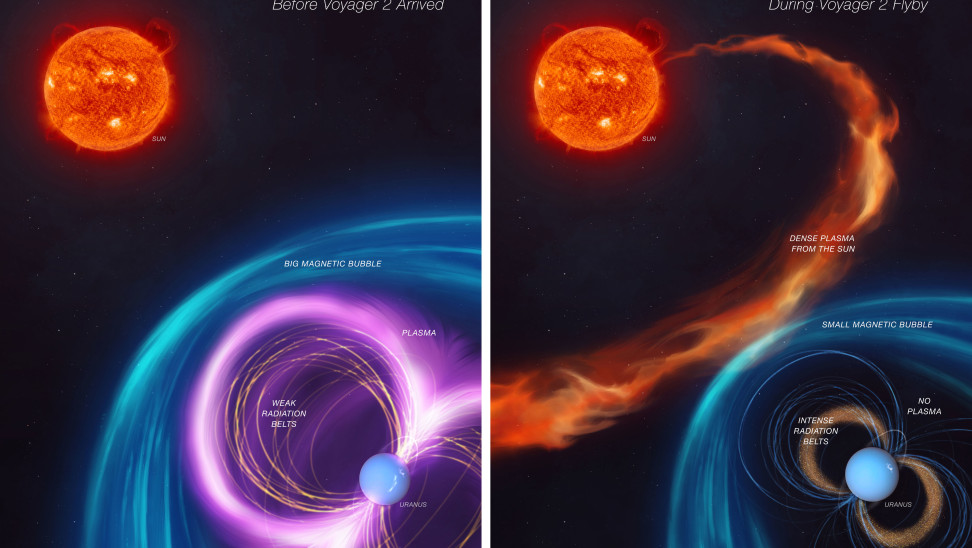Voyager 2 traveled more than 1.8 billion km in nine years to reach Uranus – NASA spacecraft ‘visited’ Uranus amid rare solar wind
Uranus, the third largest planet in our solar system, has always been a great mystery to the scientific community. Now, it seems that our information about the “blue” planet is not as much as we thought.
A study published Monday in the journal Nature Astronomy highlights that when Voyager 2 studied Uranus in 1986, the planet was in the middle of a rare solar wind, which affected scientists’ conclusions about the blue giant.
“Our understanding of the Uranus system may be more limited than previously thought“, the scientists wrote in their text.
To seventh planet from the Sun, there has been only one visit by research spacecraft. The rest we know comes from observations by the Hubble Space Telescope and many other telescopes.
Voyager 2 set sail more than 1.8 billion km in nine years to reach Heaven. He collected most of his data on the mysterious planet, including its rings and moons, in just six hours. The results of that 1986 visit showed that Uranus’ magnetosphere, the protective magnetic field that surrounds the planets, including Earth, was unique.
It appeared to be strongly asymmetric, with surprisingly intense radiation bands, given that it appeared to lack plasma, the energetic ionized particles common to the magnetospheres of other planets.
OR Earth’s strong magnetospheredescribed by NASA scientists as a giant comet-shaped bubble, is critical to our planet’s habitability by shielding it from solar radiation and solar winds.
The authors of the study say that its spacecraft NASA passed Uranus just after a strong solar wind compressed its magnetosphere, emptying it of plasma and leaving it with “highly excited electron emission bands.”
The authors argue that if the Voyager 2 had it visited Uranus just a week earlier, the spacecraft would have encountered a magnetosphere similar to that of our solar system’s other giants, Jupiter, Saturn and Neptune.
“The spacecraft saw Uranus in conditions that occur only 4% of the time“, said Jamie Jasinski from NASA’s Jet Propulsion Laboratory in Southern California and lead author of the study.
Scientists have looked at the conditions of the solar wind in the past, but haven’t come to any major conclusions. Jasinski said in an email that he has always questioned the results of this particular flight because it is just a snapshot in time. He said he had worked on missions that orbited a planet for many years with observed changes over a longer period of time and realized that if they involved just one flyby, the observations might have been skewed.
“The extreme type of measurements Voyager 2 made always made me wonder if we caught Uranus at a very specific moment in time.“, he said.
Looking back now, rather than during a tumultuous period when NASA scientists were also examining data from Jupiter and Saturn and with “the luxury of lessons learned” from subsequent space missions, allowed the authors to apply these latest discoveries in the Uranus data,” Jasinski added.
The study also offers hope for the planet’s five large, cold, windy moons: There could be signs of geological activity after all. Originally, scientists had understood that the lack of plasma in the Uranus meant that the moons were inactive.
OR Fran Bagenala professor of astrophysics and planetary science at the University of Colorado at Boulder and a member of Voyager’s plasma science team, said that at the time of the flyby, the team “hit by the strange magnetic field” so tilted from the planet’s axis of rotation and “didn’t think much more”.
The low density of the plasma did not seem so unusual to her at the time, because the moons of Uranus were very small. Bagenal said she is still skeptical that there can be liquid layers under the ice on the moons, the ice layers are hundreds of km thick and “too cold to support even primitive life forms».
THE Jonti Hornera professor of astrophysics at the University of Southern Queensland in Australia, was not involved in the study, but said the findings make a good argument for spending more time in orbit.
The study authors say their research underscores the need for future missions to better understand Uranus.
A 2022 survey of the National Academies of Sciences, Engineering and Medicine called on NASA to make another mission to Uranus a priority in the next decade, spending a year orbiting the planet and sending a probe into its atmosphere.
Source :Skai
I am Terrance Carlson, author at News Bulletin 247. I mostly cover technology news and I have been working in this field for a long time. I have a lot of experience and I am highly knowledgeable in this area. I am a very reliable source of information and I always make sure to provide accurate news to my readers.











